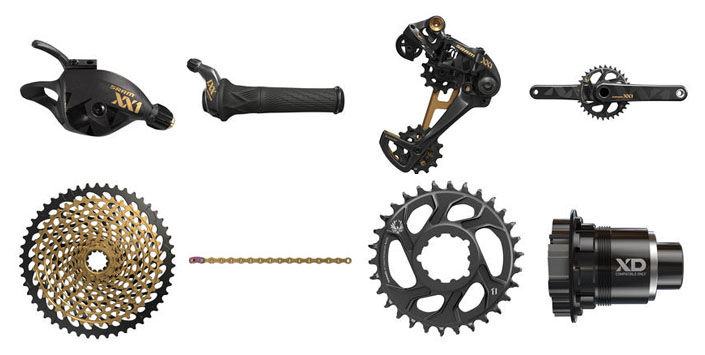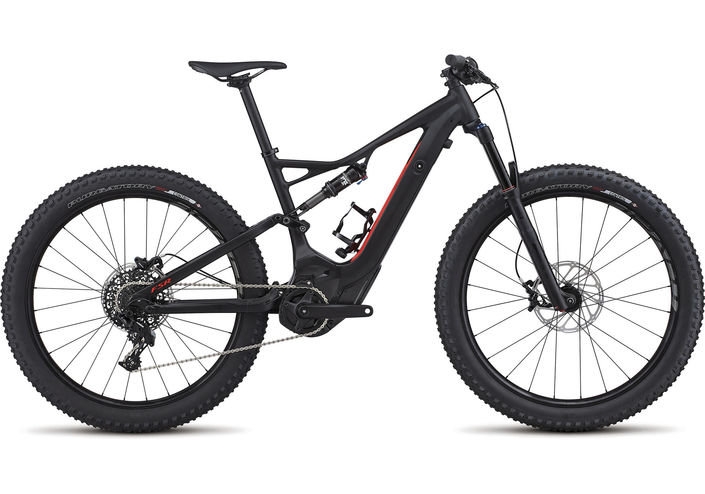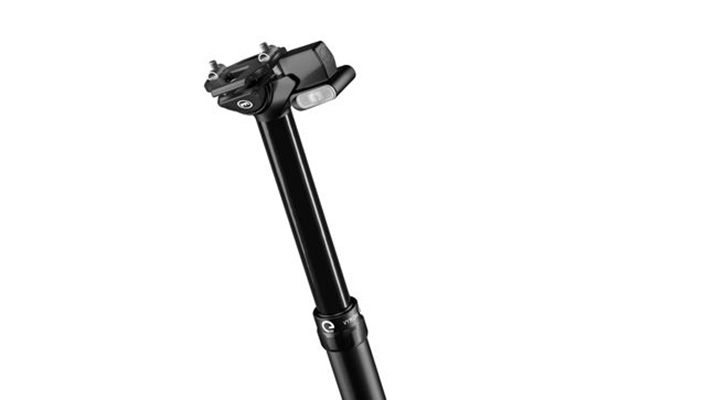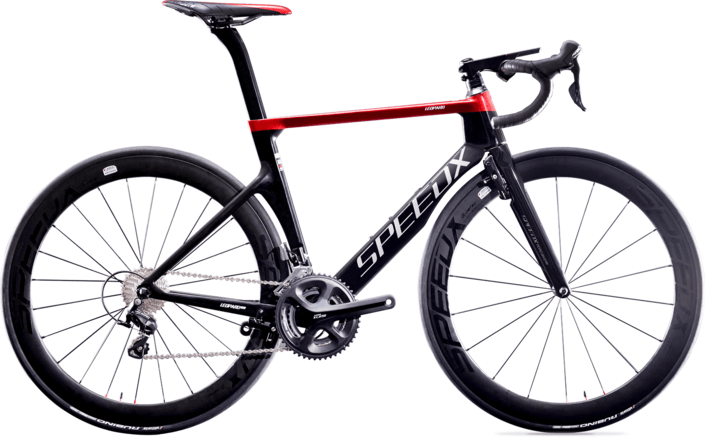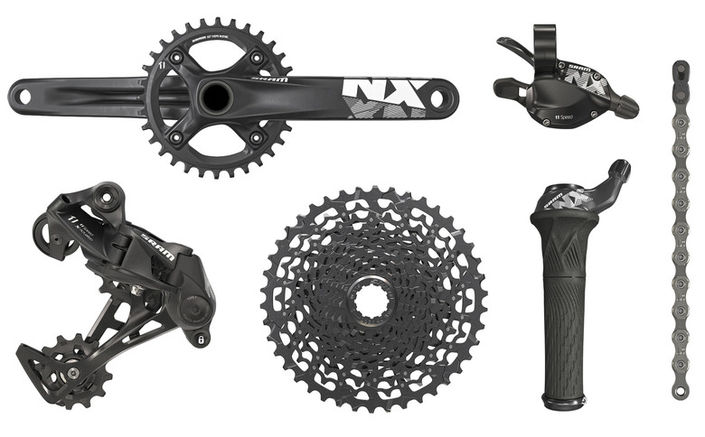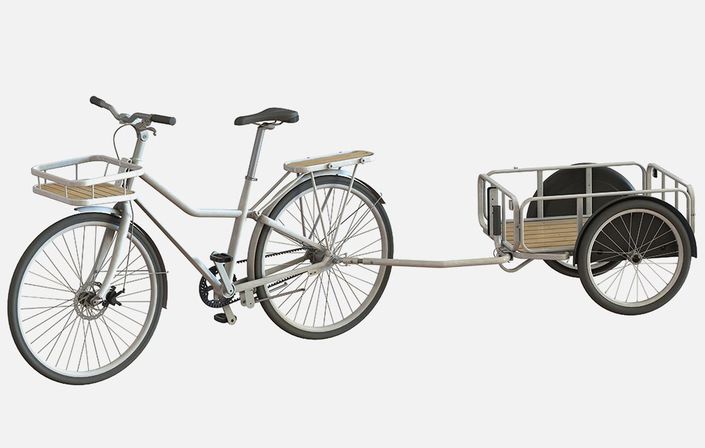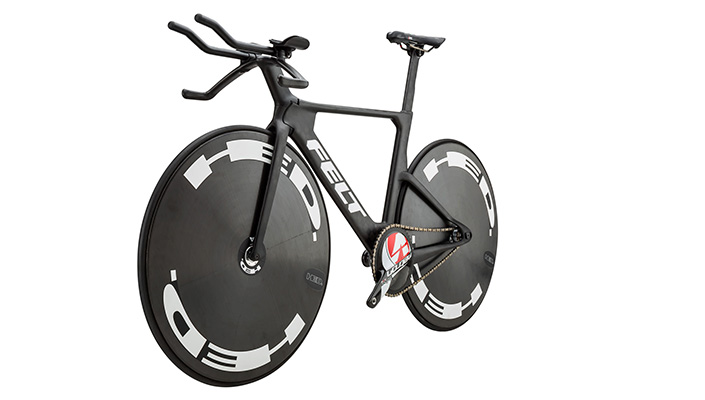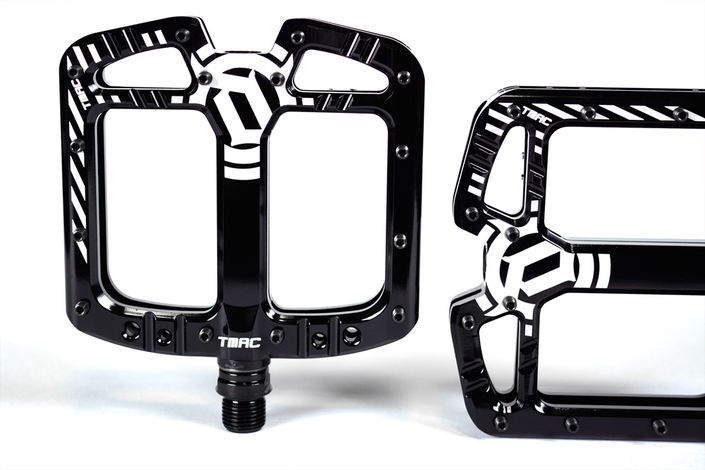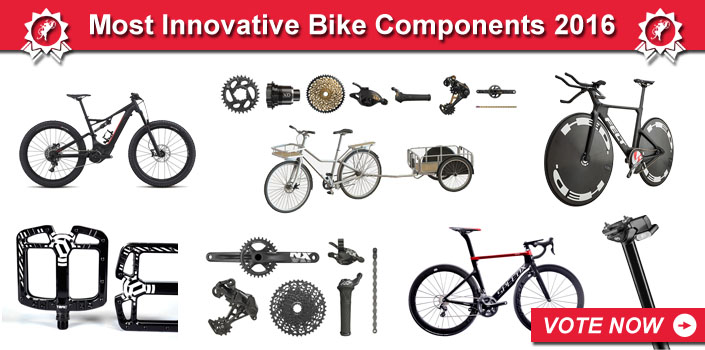
It's been another big year in the ongoing development of our favorite machine, the humble bicycle. Here are a few outstanding innovations, so far this year, that caught our eye and captured our imaginations.
SRAM Eagle 12 Speed Drivetrain
What's better than a traditional 2X shifting system and a newfangled 1x11 system? The new Eagle 12-speed drivetrain from SRAM. With a full 500% range of gears, the Eagle 12 effectively captures the gear ratios of a 2X system without the weight and hassle of an extra chainring, derailleur, or shifter.
Eagle moves over the cogs fluidly and without hesitation, though the feel of shifts is still unmistakably SRAM, with a very positive and precise action and trademark SRAM click.

The location and position of the shifter feels great and there is no free play in the shift paddle, which means no lag time between selection and engagement. A newly-designed chain - flatter, narrower and smoother than its predecessor - has fewer sharp edges, is noticeably quieter, and will apparently last significantly longer.
All good stuff, and all very interesting - but what really steals the show is the MASSIVE dinner-plate-sized 50-tooth cog. It looks truly enormous on the bike (especially a bike with a small frame like we at BikeRoar had), but while the eight-tooth jump from the 50 to the 42-tooth cog looks rather large, it's actually in line with the steps across the rest of the cassette at 19%, and the steps from there down through the rest of the gears are identical to the 11-speed version. But oh, that 50-tooth cog... it seems to represent freedom and unexplored single track and forest trails and... you get the idea.
Specialized Levo Electric MTB
Lots of manufacturers are getting into the e-mountain bike market, and they generally do this by taking their most popular series of MTBs and slapping on an electric motor. Specialized have done exactly the opposite with the Levo, designing it as an e-bike from the very beginning. To help balance the bike, Specialized designed its own motor, although the battery is similar to the one found on its Turbo S urban bike range.
The compact motor sits inside a frame shaped specifically for this particular unit—because it's custom built, Specialized could move the motor slightly further forward and lower (toward the bottom bracket and closer to the position of the battery) to minimize the effect that this extra weight has on the bike's performance. Essentially, it handles like a heavyset dual suspension MTB rather than a clumsy motorbike.
In terms of adaptability, this bike is unrivaled. There is a built-in power meter and the battery constantly communicates with your Garmin or other ANT+ GPS device. Once paired, you can monitor battery life or toggle between the three available power modes from your Garmin. The wattage of each mode (Eco, Trail, and Turbo) can be customized - or by using the "Smart Control" mode via the control panel, your Garmin, or your smartphone (by downloading the Mission Control app developed by Specialized), the rider can program in the duration of an upcoming ride in hours, kilometers, or miles, and the bike will take over the management of battery life and provide optimal useable wattage throughout the ride. Like them or not, e-bikes are here to stay, and Specialized have clearly decided to build them properly.
Magura Vyron Wireless Dropper Post
Officially announced in 2015, but finally available to purchase now, the Magura Vyron wireless dropper post is the first of what will be many wireless components. The dropper is air-sprung and hydraulically controlled by an ANT+ wireless transmission unit. The post is completely free of any cables and hoses, making it a breeze to install and reducing the maintenance required for traditional dropper posts. What's good for consumers is also good for the manufacturers as they will no longer have time and costs associated with the tedious task of running internal cables and bleeding dropper systems.
The motor is quiet and only has a minor reaction delay when the handlebar mounted button is depressed; something to get used to, yes, but it works flawlessly. The post should get roughly 2 months of use between charges, and it's programmed to save some emergency power for when the battery does die, allowing you one last adjustment to a fixed height while you finish your ride.
SpeedX Leopard / Leopard Pro Smart Bike
It's a big claim: "the only smart aero road bike with the ability to help you train and track your progress in real time." That's what Chinese manufacturer SpeedX says about their new Leopard and Leopard Pro road bikes - and so far they've been able to back it up. So what makes them so smart?
Both models (the Leopard Pro is an upgraded version of the Leopard) come with a stem-integrated out-front 2.4-inch-screen computer (known as SpeedForce) with a number of sensors dotted around the bike, including GPS, cadence, and wheel speed. They're also ANT+ and Bluetooth Smart, so when paired up with your phone or any other ANT+ device, the SpeedForce can also tell you power output, speed, cadence, altitude, gradient, and heart rate, and can field incoming phone calls, texts, and emails. The data from the SpeedForce stem will sync with the company's own SpeedX app, similar to Strava, allowing the rider to access performance data with a smartphone. The app will allow riders to share data with other users, and to post performances on a network-wide virtual leader board.
There's also an integrated rear LED light, which comes on automatically when a light sensor in the stem detects darkness. The battery powering it all lives in the seat tube, and apparently it will last for up to 40 hours and take only 30 minutes to charge. Both models come with impressive specs, including some beautifully concealed TRP TTV brakes. The frames and integrated SpeedForce stems are the same on both, but the top-of-the-range Leopard Pro boasts Shimano Di2 electronic shifting and 50mm carbon clincher wheels while the standard Leopard comes with a Shimano 105 drivetrain and 40mm clinchers.
It's still early days, and at this stage the bikes are still in pre-order phase, but if SpeedX deliver on their promises this bike is a game-changer.
SRAM NX 11 Speed Drivetrain
SRAM 1x11 technology continues to trickle down through the drivetrain ranks and the latest beneficiary is the NX groupset. There are two huge benefits to the MTB community with the release of the NX: not only does it represent a massive decrease in price, it also offers something new in terms of the cassette. Rather than relying on SRAM's XD driver, the new PG-1130 cassette uses a standard 9/10/11 speed freehub that lowers the barrier to entry even further. Now you have a group that offers most of the 1x advantage that is also affordable, and accessible. The downside? Well, there's two. Firstly, the NX cassette offers an 11-42 tooth range as opposed to the 10-42 available in XX1... not really a big deal for most of us mortals, but if you love to hammer your MTB at top speed on paved roads it could be an issue.
Secondly, the NX is the first SRAM wide range cassette that uses a multi-piece assembly that is comprised of 16 pieces including the lock ring and spacers. With the exception of the 3 largest cogs, the remaining 8 cogs are individual. This is in stark contrast to the 1-piece solid construction of the XX1's X-Dome cassette. BUT... it's a very affordable way to get into the 1X market, and it's SRAM. What have you got to lose?
IKEA SLADDA Bike, Trailer, & Accessories
Yes, you read it right. Having flooded the world with furniture, throw-rugs, and meatballs, IKEA have now come out with their belt-driven, two-speed bike complete with accessories such as a trailer, front and rear panniers, front rack, and IKEA helmet.
Naturally enough, the bike, dubbed the SLADDA, which means "skid" in Swedish, comes flat-packed, although IKEA claim it's a simple matter of attaching the front wheel, handlebars and double-sided kickstand. Bicycle self-assembly is a bold move that will either prove to be a masterstroke of cost-saving genius or a recipe for carnage on the roads and bike paths.
All mockery aside, though, it's actually a pretty good bike. It's super low-maintenance, with the belt drive supposed to last for 15,000km - additionally, belt drives are quieter and much, much cleaner than chains. The pedaling mechanism is eerily silent and the old-school back-pedal rear brake and front disc brake provide enough stopping power for a bike that will, in all likelihood, be ridden at moderate speeds.
The internal hub gearing offers two speeds, but cadence and forward speed dictate which gear the bike automatically selects: it's a nice concept, but will definitely take some getting used to.
The utilitarian grey paintwork is kind of cool in an industrial sort of way, and overall it's a good-looking bike. What I really appreciate, though, is the spirit - dare I say culture? - that IKEA are trying to promote by suggesting that most places we drive to can be reached by bike. Got a whole bunch of flat-packed furniture in cardboard boxes that you just bought from a gigantic anonymous Scandinavian retailer? No problem, just stack them up in your IKEA trailer, hook it up to your IKEA bike, and when you get home you can assemble your new furniture with the same hex key you used to build your bike.
Felt TA FRD - Left drive track bikes by Felt / USA cycling
Even without the left-hand cranksets, the Felt TA FRD is an impressive bike. The major innovations include an asymmetrical frame design, an aerodynamic chain ring cap, and a Stages power meter with dual sensors. The HED wheels have been specially designed to fit the narrower aerodynamic fork and rear stays.
The bike has been synchronized by IBM to show power, lap times, muscle oxygenation and other vital data on a head-up display in the Solos smart eyewear that comes with the bike.
But, of course, the really freaky bit is the left-side drive train. Glance quickly at the bike out of the corner of your eye - your brain tells you something is wrong, and it takes a while to come to grips with the idea that the chain and drivetrain are on the wrong side!
It kind of makes sense, though - the idea is aimed at improving aerodynamics and combating the slight yaw found at indoor velodromes... turn to the left, lean to the left, drivetrain on the left. Aboard it, Team USA captured two Olympic silver medals in Rio, one for the women’s team, breaking a world record in the semifinals, and another by Sarah Hammer in the women’s omnium. Very cool indeed.
Deity T-Mac Pedal
Innovation is not just coming up with new concepts or products, it's also improving upon things that have been accepted for decades. Case in point: the Deity T-Mac flat pedal. Where most riders and manufacturers saw a basic slab of aluminum or carbon fiber, the team at Deity saw an opportunity.
This pedal is unique in that the platform or body of the pedal is centered upon the axle, unlike other mainstream brands which offset their pedals slightly. This offset was a big help back in the days when pedals were thick and flat, but Deity have manufactured a pedal that is thin and strong enough to bring the rider's foot closer to the spindle - additionally, they've made the pedal concave rather than flat, which adds a tremendous amount of traction and confidence.
So which product do you think represents the greatest innovation so far this year? Tell us with your vote below - VOTE NOW!
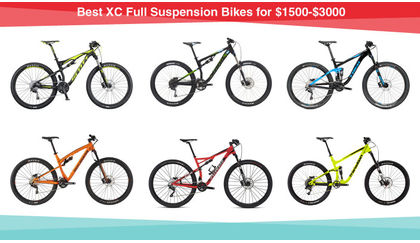
RELATED ARTICLE:
Best XC Full Suspension Bikes for $1500-$3000
Looking for a new XC bike can be confusing and expensive so we thought we would stream line the process for you! BikeRoar has 6 best full suspension XC bikes from... READ MORE

RELATED ARTICLE:
Road Bikes: 6 best bets from $2,000 to $3,500
In the market for a new road ride but not sure what to buy? BikeRoar has 6 best bets for road bikes from... READ MORE
